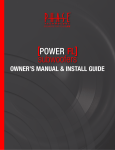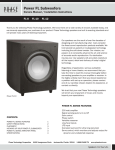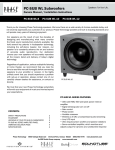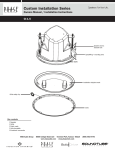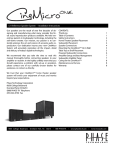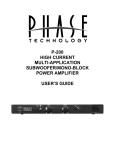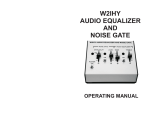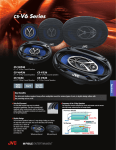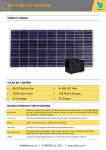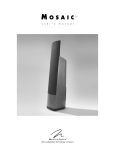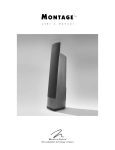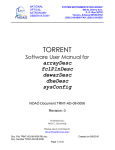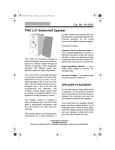Download Phase Technology V5520 User's Manual
Transcript
Phase Velocity Series V52 · V5520 · V62 · V-Surround-II · V626 Installation Instructions Thank you for your purchase of this Phase Velocity product. Our mission and passion is to constantly advance the art and science of accurate audio reproduction. We are confident that your Phase Technology speaker will accurately reproduce all the impact, detail and delicacy of today’s digital technologies. We recommend that you take the time to read this manual thoroughly before connecting speakers to your amplifier or receiver. In the highly unlikely event that you should experience a problem with set-up or operation, please contact one of our carefully chosen dealers for assistance, or contact us directly. Phase Technology Corporation 8650 College Boulevard Overland Park, KS 66210 (913) 663-9770 Telephone (888) PHASE-TK Toll-Free (USA & Canada) (913) 663-9790 Fax CONTENTS: Thank you1 Table of Contents1 Safety Instructions2 Home Theater Speaker Placement 3 Subwoofer Application Note3 Speaker Connections4 Mounting Your Speaker On A Wall 5 V626 Foot Installation / Spike Installation 5 V5520 Foot Installation6 Table Top or Shelf Placement 6 Stereo / Two Channel Operation 6 Amplifier Setup and Bass Management 6 Caring for Your Phase Technology Speaker 6 Maintenance and Service7 Troubleshooting7 Specifications8 8650 College Boulevard • Overland Park, KS 66210 • www.phasetech.com • www.mseaudio.com R Copyright © 2011 Phase Technology Corporation. All Rights Reserved. AN MSE AUDIO GROUP MEMBER SAFETY INSTRUCTIONS CAUTION RISK OF ELECTRIC SHOCK DO NOT OPEN CAUTION: To reduce the risk of electric shock, do not remove cover (or back). No user-serviceable parts inside. Refer servicing to qualified service personnel. Explanation of Graphical Symbols The lightning flash with arrowhead symbol, within an equilateral triangle, is intended to alert you to the presence of un-insulated “dangerous voltage: within the product’s enclosure that may be off sufficient magnitude to constitute a risk of electric shock to persons. The exclamation point within an equilateral triangle is intended to alert you to the presence of important operating and maintenance (servicing) instructions in the literature accompanying the appliance. 1. Read Instructions - All the safety and operating instructions should be read before the appliance is operated. 2. Retain Instructions - The safety and operating instructions should be retained for future reference. 3. Heed Warnings - All warnings on the appliance and in the operating instructions should be adhered to. 4. Follow Instructions - All operating and other instructions should be followed. 5. Water and Moisture - The appliance should not be used near water - for example, near a bathtub, washbowl, kitchen sink, laundry tub, in a wet basement, or near a swimming pool, etc. 6. Carts and Stands - The appliance should be used only with a cart or stand that is recommended by the manufacturer. ventilation. For example, the appliance should not be situated on a bed, sofa, rug, or similar surface that may block the ventilation openings; or placed in a built-in installation, such as a bookcase or cabinet that may impede the flow of air through the ventilation openings. 9. Heat - The appliance should be situated away from heat sources such as radiators, stoves, or other appliances that produce heat. 10. Power Source - The appliance should be connected to a power supply only of the type described in the operating instructions or as marked on the appliance. 11. Power Cord Protection - Power supply cords should be routed so that they are not likely to be walked on or pinched by items placed up or against them, paying particular attention to cords at plugs, convenience receptacles, and the point where they exit from the appliance. 12. Cleaning - The appliance should be cleaned only as recommended by the manufacturer. 13. Nonuse Periods - The power cord of the appliance should be unplugged from the outlet when left unused for a long period of time. 14. Object and Liquid Entry - Care should be taken so that neither objects fall nor liquids spill into the inside of the appliance. 15. Damage Requiring Service - The application should be serviced by qualified service personnel when: a. the power supply cord or the plug has been damaged, b. objects have fallen onto or liquid has been spilled into the appliance, c. the appliance has been exposed to rain, d. the appliance does not appear to operate normally or exhibits a marked change in performance, or e. the appliance has been dropped or the cabinet damaged. 16. Servicing - The user should not attempt to service the appliance beyond those means described in the operating instructions. All other servicing should be referred to qualified service personnel. 17. Grounding or Polarization - Precautions should be taken so that the grounding or polarization means of an appliance is not defeated. PORTABLE CART WARNING APPLICABLE FOR USA, CANADA OR WHERE APPROVED FOR USAGE CAUTION: TO PREVENT ELECTRIC SHOCK, MATCH WIDE BLADE PLUG TO WIDE SLOT, INSERT FULLY. 7. Wall or Ceiling Mounting - The appliance should be mounted to a wall or ceiling only as recommended by the manufacturer. 8. Ventilation - The appliance should be situated so that its location or position does not interfere with its proper ATTENTION: POUR EVITER LES CHOCS ELECTRIQUES, INTRODUIRE LA LAME LA PLUS LARGE DE LA FICHE DANS LA BORNE CORRESPONDANTE DE LA PRESE ET POUSSER JUSQU AU FOND. 2 HOME THEATER SPEAKER PLACEMENT Today’s digital multi-channel home theater technology has elevated the art of “surround sound” to reproduce the movie theater experience in your own home. Speaker requirements and placement are important when reproducing these multi-media effects. Two front speakers (left and right), two surround speakers (left and right), a center-channel speaker, and a subwoofer define the minimum arrangement for multi-channel systems such as Dolby® Pro Logic, DTS®, Dolby® Digital, Dolby® TrueHD and DTS® HD Master Audio. Your Phase Velocity speaker has been designed for optimal performance with these systems. You will get the best results if you use the same type of speakers throughout your home theater (for example, match a pair of Phase Velocity Bookshelf Speakers with the V626 Tower, V5520 Center Channel, and V-Surround-II units). Placement of speakers in your room will impact the final listening experience. To position your speakers, there are some general guidelines that take room size, shape, and fixtures and furnishings into account. Use the following illustrations as a general guide for speaker placement in a typical home theater system. LF C RF LF SUB C RF SUB SUB RS LS LS RS LR 5.1 HOME THEATER SYSTEM RR 7.2 HOME THEATER SYSTEM In a 5.1 home theater system, the center channel (C) should be placed at 0º directly below or above the video screen, the left front (LF) and right front (RF) speakers should be placed at 30º from the listening area, and the left and right surrounds (LS and RS) should be placed at 110º. All five speakers should be placed at or near ear level. In a 7.2 home theater system, the center channel (C) should be placed at 0º directly below or above the video screen, the left front (LF) and right front (RF) speakers should be placed at 30º from the listening area, and the left and right surrounds (LS and RS) should be placed at 90º. The left rear (LR) and right rear (RR) speakers (sold separately) should be placed at 150º. All seven speakers should be placed at or near ear level. Front speakers should be placed 6-8 feet apart (or on the sides of your screen if your screen is wider) to fully separate the left and right channels. Whether placed on speaker stands, on shelves, or on the wall your speakers should be at or slightly above ear level. Rear surround speakers also should be placed at or slightly above your listening position for the best reproduction of surround sound effects. Ideally, they should be facing into your favorite listening position from either side of the room. Center speaker placement should be, if possible, directly on top of or under your TV monitor or projection TV screen, in a horizontal orientation, centered with your video screen. This correctly positions the critical sound track information (usually dialogue) that filmmakers direct to the center channel. SUBWOOFER APPLICATION NOTE Subwoofer placement is less critical, because the frequencies they reproduce are omni directional. This means the human ear doesn’t perceive these low frequencies as coming from a specific direction, enabling placement of a subwoofer virtually anywhere in the listening room. It’s best, however, to keep a subwoofer within the sound field of the other speakers. The closer the subwoofer is to a wall, the louder and more intense its bass output will be: this effect is even stronger when the sub 3 is placed in or near a room’s corner. If using two subwoofers, start by placing them next to the front left and right speakers, in both front corners or one in the corner and one 1/3 of the way along the front wall from the corner. Each room is different. Experiment with these options or try other locations until you get the best results. If you must choose a less-than-ideal position, the output level of Phase Technology powered subwoofers is adjustable to compensate for your listening environment. Please refer to your subwoofer manual for more information. SPEAKER CONNECTIONS The following instructions apply whether you are using a separate amplifier or Home Theater receiver. For simplicity we will use the term “amplifier” throughout this manual to mean both. Special note: Turn off and unplug your amplifier before connecting speakers. Special Note: Observe Speaker Polarity Carefully! Every cable, speaker and amplifier is clearly marked to show their positive (+) and negative (-) terminals. Amps and speakers may use some combination of these symbols and/or colors to indicate positive (usually red) and negative (usually black or white) connections. One strand of your cable will also be ridged and/or marked with a colored line or other indicator on the positive side. For proper polarity and, thus, ideal system performance, always connect the positive side of the cable to the positive terminals on your speakers and amplifier and the negative side of the cable to the negative terminals. Front Speakers: The pair of front speaker connections (left and right) on your amplifier will be labeled “Front” or “Main.” Connect the speaker cables for your left and right front speakers using these terminals and then connect the cables to the front satellites. Observe positive and negative polarities. V626 Bi-Wiring: The V626 speaker is equipped with bi-wiring, with four speaker terminals instead of two. This may enhance speaker performance by using an additional pair of speaker cables. In order to bi-wire this speaker, remove the gold-plated strips between the speaker terminals and connect two cables between your amplifier’s positive output terminal and the two positive (red) terminals on the speaker. Then connect the other two cables between the amp’s negative output terminal and the two negative (black) terminals on the speakers. If you choose not to bi-wire your speakers, do not remove the metal strips between the speaker terminals. Connect each cable in the standard manner, with one cable each between the positive and negative speaker terminals and your amplifier. Center Speaker: The center speaker connections on your amplifier will be labeled “Center” or “Center Channel.” Connect the speaker cables for your center channel speaker using these terminals and then connect the cables to the center speaker. Observe positive and negative polarities. Surround Speakers: The pair of surround connections (left and right) on your amplifier will be labeled “Surround.” Connect the speaker cables for your left and right surround speakers using these terminals and then connect the cables to surround satellite speakers. Observe positive and negative polarities. Phase Velocity Surround speakers are marked with arrows indicating “left” or “right” to denote how the speaker should point into the listening area. Make sure you are connecting the proper speaker to the proper set of wires before mounting. Rear Surround Speakers (used in 7.1 and 7.2 systems): The rear channels (left and right) on your amplifier will be labeled “Left / Right Rear Channels” or “Left / Right Back Surrounds”. Connect the speaker cables for your left and right rear speakers using these terminals and then connect the cables to the rear speakers. Observe positive and negative polarities. Subwoofers: Phase Technology recommends the use of HV Series or Power FL subwoofers with the Phase Velocity system, however, any subwoofer will work. Please consult your subwoofer’s installation manual for connection instructions. 4 Left LCR Right LCR Center LCR Subwoofer Line Input Amplifier Panel SUB OUT Left Right Front Front Left Rear Right Rear Left Right Surr. Surr. Center Channel Left Surround Right Surround Left Rear Right Rear MOUNTING YOUR PHASE VELOCITY SPEAKER ON A WALL The V-Surround-II speaker includes a keyhole type insert for on-wall mounting. Use a #6 screw in a drywall anchor capable of holding 2-3 times the weight of the speaker in the location you wish to mount the speaker. Then slide the keyhole over the screw. The self adhesive bumpers included with the speaker may be used on the rear of the speaker to provide a gap for running speaker wires. Make certain that your wall anchors are capable of supporting the weight of the speaker! The V52, V62 and V5520 speaker includes M6 (6mm) threaded inserts for use with standard wall mounting brackets (available from third party vendors). Please refer to the vendors’ instructions for mounting speakers to their wall mounting brackets. V626 FOOT INSTALLATION The V626 Tower Speaker comes with four feet that mount to the bottom of the unit. To mount the feet, turn the speaker over, place each foot in place on a corner of the unit so that the screw holes line up with the threaded inserts on the speaker, and attach the feet using the provided screws. Tighten snugly but do not over tighten. V626 Floor Spikes Floor spikes are provided with V626 speakers to steady the speaker cabinets, especially on carpeting and uneven floor surfaces. Because most speakers tend to rock back and forth in small increments due to the force of the in/out motions of speaker drivers, these movements can affect the speakers’ performance. Attach the floor spikes by screwing them into the pre-drilled holes in the base of the speaker (they will attach through the speaker feet; be sure to attach feet first) and tighten the nuts securely. The sharp points will penetrate the carpet to make a more solid contract with the underlying floor surface. 5 If your floor is not rigid, the spikes may actually add to the rocking motion, so we recommend you audition the speakers with and without the spikes inserted to see if you discover a personal preference in the sound quality. Be especially careful when moving speaker cabinets with the spikes attached, as the points could damage carpeting or scratch floors. V5520 FOOT INSTALLATION Apply two of the provided adhesive bumpers to the two front corners of the speaker. Insert one of the two supplied 6mm Phillips screws through the recessed hole of the plastic legs and screw the legs to the bottom of the speaker cabinet insert locations. Adjust the angled end of the leg so it will set level on your shelf or tabletop before tightening the screws completely. For vertical placement, apply the four adhesive bumpers to one end of the speaker, placing them at the corners of the cabinet. TABLE TOP OR SHELF PLACEMENT (V52, V62, V5520, V-SURROUND-II) Included with your Phase Velocity speaker are self adhesive bumpers that can be used on the bottom of the speaker to protect the finish and surface when placing it on a shelf or table top. Simply peel off the bumpers from the backing paper and apply them to the bottom of the speaker. STEREO (TWO CHANNEL) OPERATION - FIRST LISTENING Play a stereo CD that contains a strong solo vocalist. Sit at your normal listening position and listen to the singer. If the artist sounds “center stage” with music coming between the speakers, the speakers are in phase. On the other hand, if vocals sound as if they are coming from the two sides or are not focused in the central area, the speakers may be out of phase. In this event, turn off the power, unplug your amplifier or receiver and check that the leads are hooked up correctly. Then, turn everything on and listen again. When the sound is natural and the soloist appears to be in the middle of the sound stage, the speakers are in phase. Two-Channel Speaker Placement Phase Technology speakers utilize our Absolute Phase™ crossover network. This design permits a much wider vertical output pattern than conventional speakers, allowing you to achieve the best quality musical experience regardless of speaker placement. For example, your speakers can be placed either vertically or horizontally on a bookshelf and will provide seamless transition of sound from one speaker to another even if the speakers cannot be placed at the traditional “ear level” height recommended by most manufacturers. In most rectangular rooms speakers sound best when placed along one of the short walls. Begin by placing the speakers 1 – 3 feet away from the wall and approximately 6 – 8 feet apart. The exact final placement will be determined by how far away you are sitting from the speakers and other interior environmental factors. We suggest playing a familiar piece of music and adjusting the placement of the speakers until the desired sound is achieved. Sometimes larger bookshelf speakers will sound better when placed upon stands designed expressly for the purpose of supporting them above floor level. By “de-coupling” the speaker cabinet from the floor, bass frequencies are tighter and high frequencies more distinct. Stands are available in a wide variety of types, sizes and price ranges from your local retailer. Smaller speakers can be placed in bookshelves or cabinets; however, some loss of imaging may be experienced. Again, only trial and error will determine the best possible result for your circumstances. AMPLIFIER SETUP AND BASS MANAGEMENT Many home theater receivers/processors have a feature that controls how the bass is processed and delivered to the subwoofer. It also adjusts the amount of bass that is sent to your satellite speakers. Look carefully in your amplifier or receiver’s instruction manual for details on how to adjust for the speaker size (sometimes called “Speaker Setup”) for your system. CARING FOR YOUR PHASE TECHNOLOGY SPEAKER All Phase Technology speakers are finished with a high degree of craftsmanship in either hand polished paint or vinyl laminates. We recommend using a lint-free rag with a small amount of glass cleaner to maintain the long-lasting beauty of the finish. Avoid products containing silicones, oils, oil derivatives, or solvents. Enclosures finished in vinyl laminates may be cleaned with a damp cloth as necessary. 6 MAINTENANCE AND SERVICE Because of Phase Technology’s uncompromising quality control programs, it’s unlikely that your speakers will ever need service if connected and used as outlined in this Owners’ Manual. In the unlikely event that a problem does occur, please contact your Phase Technology dealer. Your dealer has the necessary factory-authorized parts and trained technicians to quickly restore your speaker to its original performance specifications. TROUBLESHOOTING No sound 1. 2. 3. Verify that all components are plugged in and turned on. Check all speaker wires and cables for loose connections. Check to see if you have selected the proper source on your amplifier. Voices do not appear to come from between the speakers / bass response is weak 1. Verify that all speaker connections from the amplifier to the speakers are running PLUS+ to PLUS+ and MINUS- to MINUS-. 2. Check to see if there are any furnishings or plants that may be blocking the output of a speaker. Make sure nothing is directly in front of that speaker. Sound, but no bass (most likely in systems with a subwoofer) 1. 2. 3. 4. Verify that the subwoofer is plugged into an AC outlet and power is turned on. Check that the speaker wire / cable going from the amplifier/receiver to the subwoofer is securely fastened. Check the volume control of the subwoofer. Refer to your amplifier/receiver manual to make sure you have adjusted its bass output properly. Muddy or boomy bass 1. Check the volume control for the subwoofer. Excess volume can cause speakers to sound distorted and unnatural. 2. Try adjusting the crossover control on the subwoofer (or the subwoofer setup on your receiver) to a slightly lower frequency (example: reduce from 120 Hz to 80 or 60 Hz). 3. If the subwoofer or full size speaker is close to a corner, side or back wall, try moving it away from the wall. This may reduce the “boomy” bass considerably. 4. Bookshelf speakers placed in a semi-enclosed space or cabinet can artificially emphasize bass output. Reduce the bass control on your amplifier or move the speakers to the front of the cabinet. Alternatively, reposition the speakers to a more open location. Distorted sound from the speakers 1. 2. This problem is usually caused by setting the volume control too high. Reduce the amplifier/receiver volume to a lower level. If noise and distortion are audible at higher volume levels, your amplifier may not be powerful enough. Consider upgrading to a unit with higher power. NOTE: Remember, even though your Phase Technology speakers can handle considerable power levels, ANY speaker if used improperly can be damaged. Consult your Phase Technology dealer for assistance in choosing a new amplifier or receiver. WARRANTY INFORMATION MAY BE FOUND ON THE WARRANTY CARD INCLUDED WITH YOUR PHASE VELOCITY SPEAKER. 7 V52 V626 Tweeter 1” soft dome 1” soft dome Woofer 5.25” Vapor Deposited Titanium* 2 x 6.5” Vapor Deposited Titanium Dimensions 7.4” (W) x 10.75” (H) x 8.53” (D) 8.25” (W) x 40.5” (H) x 9.53” (D) Shipping Weight System Frequency Response Sensitivity Impedance Finish Recomended Amp Power 12 lbs. 33 lbs. 58Hz - 20 kHz ( 3dB) 32 Hz - 20 kHz ( 3dB) 88 dB 89 dB 8 Ohms 8 Ohms Black Ash Woodgrain Laminate Black Ash Woodgrain Laminate 15-100w 15w - 150w SPECIFICATIONS V62 V-Surround-II Tweeter 1” soft dome 2 x 1” soft dome Woofer 6.5” Vapor Deposited Titanium 5.25” Vapor Deposited Titanium Dimensions 8.25” (W) x 13.25” (H) x 9.53” (D) 11.94” (W) x 9” (H) x 4.5” (D) Shipping Weight System Frequency Response Sensitivity Impedance Finish Recomended Amp Power 17 lbs. 18 lbs. / pair 58Hz - 20 kHz ( 3dB) 70 Hz - 20 Hz ( 3 dB) 88 dB 87 dB 8 Ohms 8 Ohms Black Ash Woodgrain Laminate Black or white laminate 15-100w 15w - 100w V5520 Tweeter 1” soft dome Woofer 1 x 5.25” Vapor Deposited Titanium woofer, 1 x 5.25” VDT bass radiator Dimensions 18” (W) x 8.53” (H) x 7.4” (D) Shipping Weight System Frequency Response Sensitivity Impedance Finish Recomended Amp Power 16 lbs. 56 Hz - 20 kHz ( 3 dB) 88 dB *Vapor Deposited Titanium is also abbreviated as VDT 8 Ohms Black Ash Woodgrain Laminate 15-100w 8








